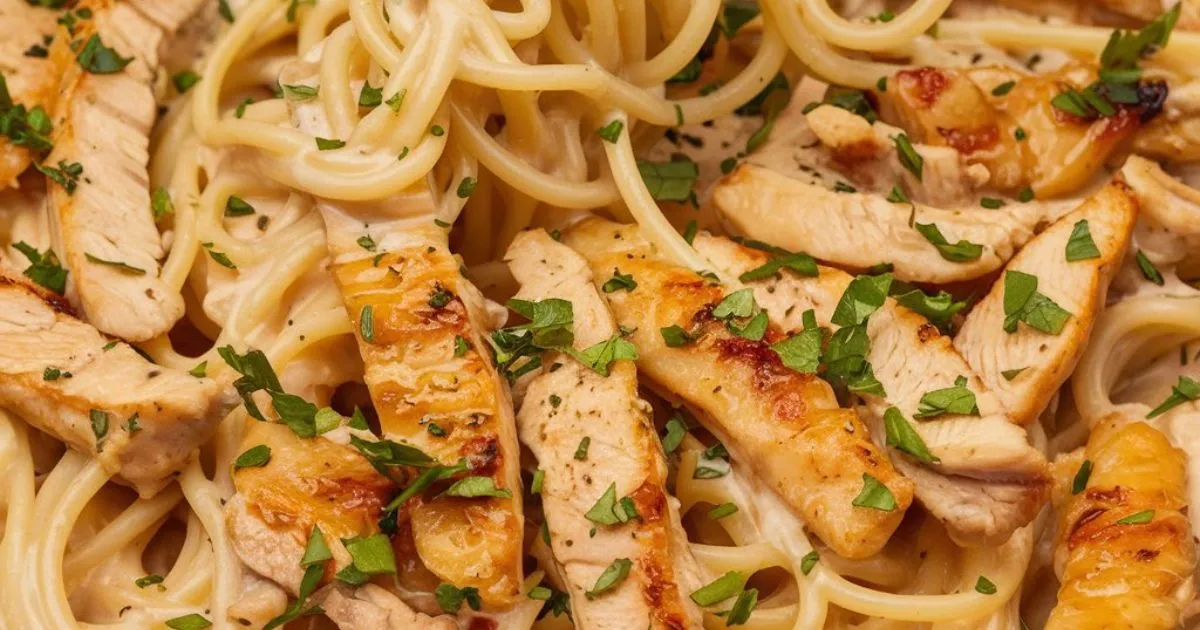Want to enjoy restaurant-style garlic parmesan chicken pasta without the hefty price tag? This foolproof recipe costs a fraction of restaurant prices and tastes just as delicious.
The creamy garlic parmesan chicken pasta needs just 30 minutes to prepare, which makes it ideal for busy weeknight dinners. Your family will love this versatile dish that pleases both picky toddlers and adults alike.
Simple, easy-to-find ingredients make this recipe a practical choice. You can customize it based on your dietary needs – make it gluten-free or add nutritious vegetables like spinach and broccoli.
Ready to create this rich, creamy comfort food that rivals your favorite restaurant version? Let’s take a closer look at the step-by-step process to make this incredible dish!
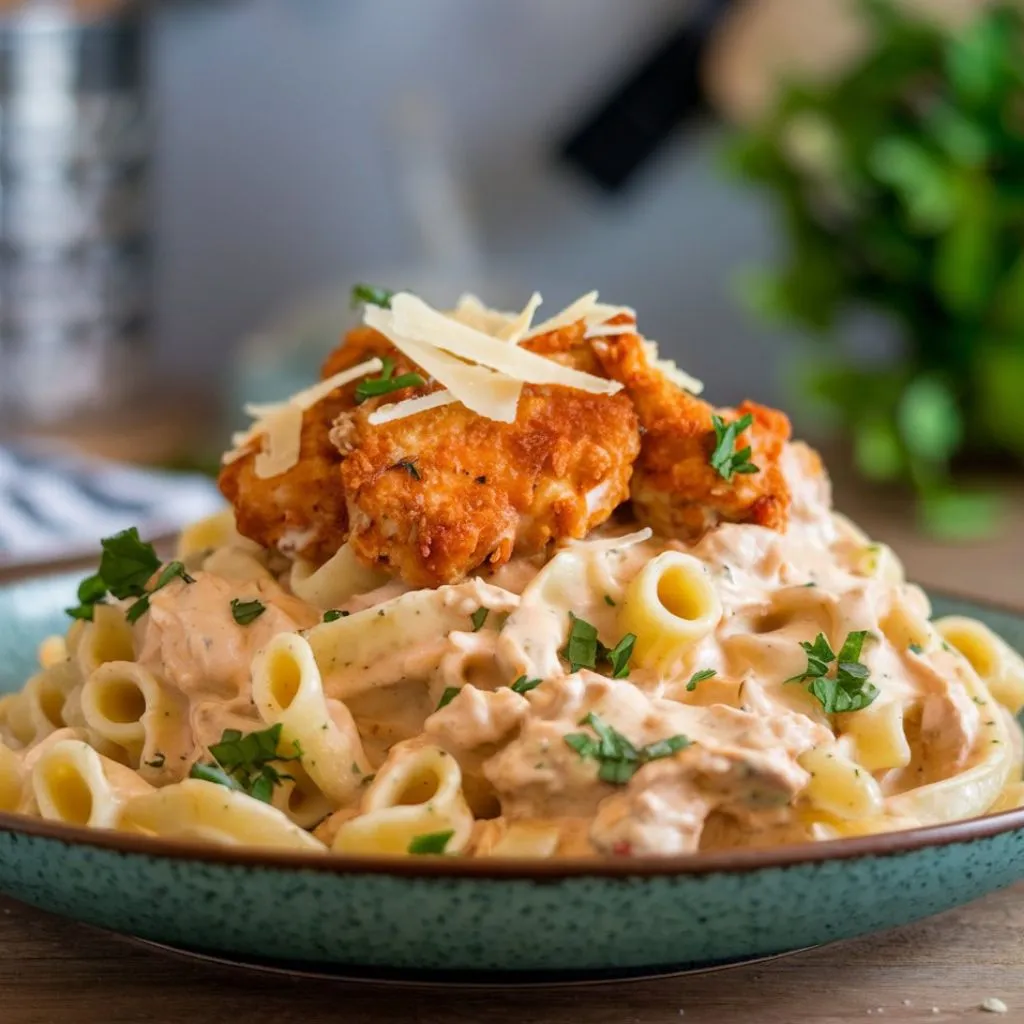
Essential Equipment and Pantry Staples
You’ll need the right tools and ingredients to make perfect garlic parmesan chicken pasta. A well-laid-out kitchen will help you prepare this dish in under 30 minutes. Let me share everything you need to create this restaurant-worthy meal at home.
Must-have tools to succeed
The perfect creamy garlic parmesan chicken pasta needs these vital kitchen tools:
- Large skillet or sauté pan – A 3-quart stainless steel pan works great for searing chicken and making the sauce. This pan will help you develop rich flavors that make this dish special.
- Pasta pot – Pick a pot big enough to let your pasta move freely as it cooks.
- Quality cutting board and sharp knife – These help you prepare chicken and mince garlic quickly.
- Box grater – Shred parmesan cheese from a block instead of buying pre-grated. Freshly grated cheese melts better and tastes superior to packaged varieties that contain anti-caking agents.
- Tongs or spider – These make it easy to move pasta from water to sauce and keep some starchy pasta water.
- Garlic tools – A good garlic press or peeler makes fresh garlic prep simple.
- Measuring cups and spoons – You’ll need these to get the amounts right.
A meat tenderizer helps flatten chicken breasts to 1/2 inch thickness for even cooking. A whisk helps create smooth, lump-free sauce.
“Cooking is like love. It should be entered into with abandon or not at all.” — Harriet Van Horne, American newspaper columnist and film/television critic
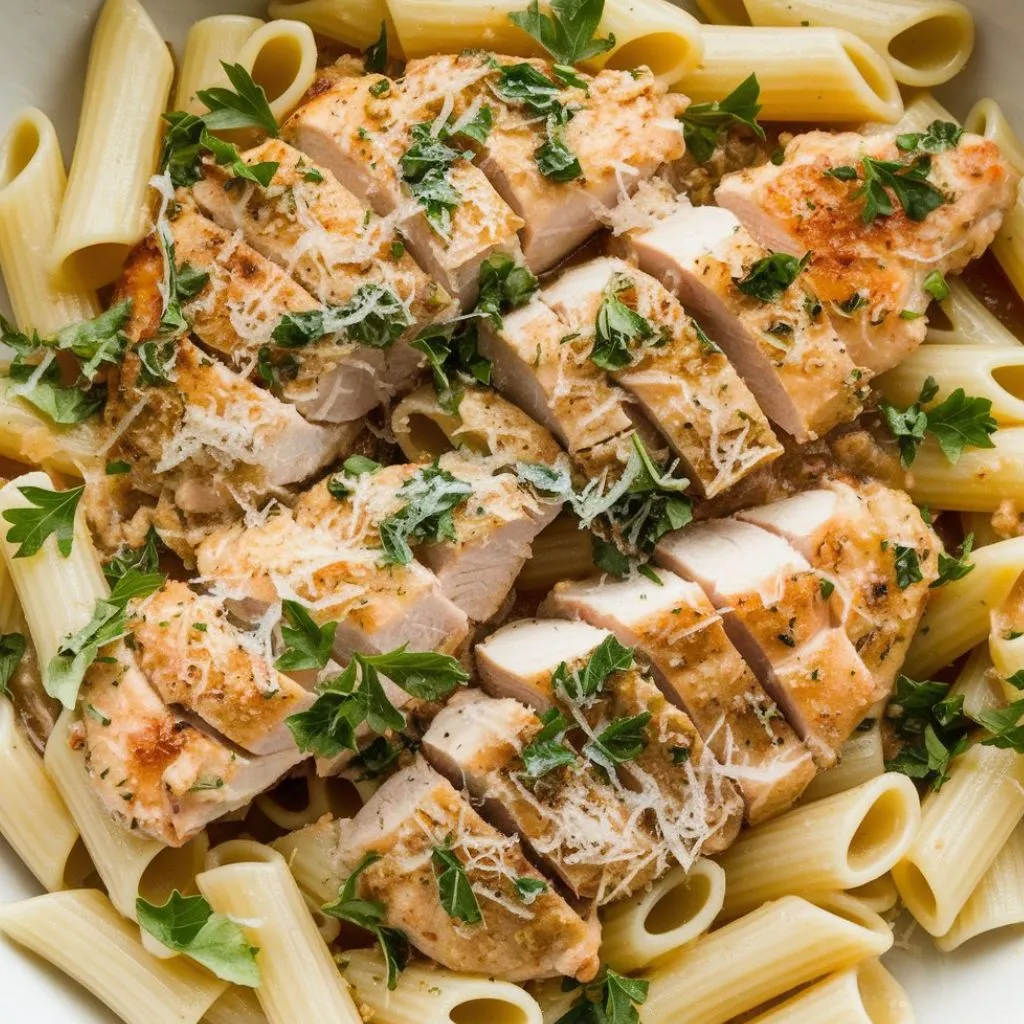
Pantry ingredients checklist
These staples are the foundations of your creamy garlic parmesan chicken pasta:
- Pasta: Quality counts – get 100% durum semolina pasta made in Italy. Short pasta shapes like penne, cavatappi, or rotini grab creamy sauce well, though fettuccine and linguine taste just as good.
- Chicken: Boneless, skinless chicken breasts or thighs work great. You’ll need about 24 ounces (3 medium chicken breasts).
- Butter: 8 tablespoons (1 stick), unsalted works best to control salt.
- Heavy cream: 3 cups give you a thick, restaurant-style sauce. This makes the right consistency – milk or half-and-half will make it too thin.
- Fresh garlic: Several cloves, minced or grated. Skip pre-minced jarred garlic – fresh tastes substantially better.
- Parmesan cheese: 4 ounces (about 1¼ cups) freshly grated. Buy a block and grate it yourself for better melting and flavor.
- Chicken broth/stock: ¾ cup adds depth to your sauce.
- Flour or cornstarch: 1-2 tablespoons to thicken the sauce.
- Salt and black pepper: To season throughout.
- Fresh herbs: Parsley adds brightness and looks great.
You probably have many of these ingredients in your pantry already, making this an impressive yet simple dish any night of the week.
Acceptable ingredient substitutions
This versatile recipe works well with different ingredients. Here’s what you can swap:
- Protein options: No chicken? Try Italian sausage, shrimp, or bacon for different flavors.
- Dairy alternatives: Want it lighter? Use half-and-half or whole milk instead of heavy cream, but expect thinner sauce. Dairy-free heavy cream works great for non-dairy diets, and so does full-fat coconut milk.
- Cheese substitutions: Fresh parmesan works best, but pecorino romano or asiago cheese tastes similar. Plant-based parmesan works for dairy-free needs.
- Gluten-free adaptations: Pick gluten-free pasta and swap regular flour with gluten-free one-to-one flour like Bob’s Red Mill, cornstarch, or arrowroot powder.
- Broth options: Vegetable broth works as well as chicken broth. White wine (about ¼ cup) can replace some broth to add complexity.
- Vegetable additions: The simple recipe tastes great, but you can add spinach, mushrooms, peas, broccoli, or asparagus to make it a complete meal. Add spinach and frozen peas at the end, and sauté mushrooms with garlic.
Water can replace chicken broth if needed; just adjust your seasonings. If the sauce gets too thick, pasta water will help you get the perfect consistency.
Now you have everything you need to make amazing garlic parmesan chicken pasta that tastes better than restaurant versions.
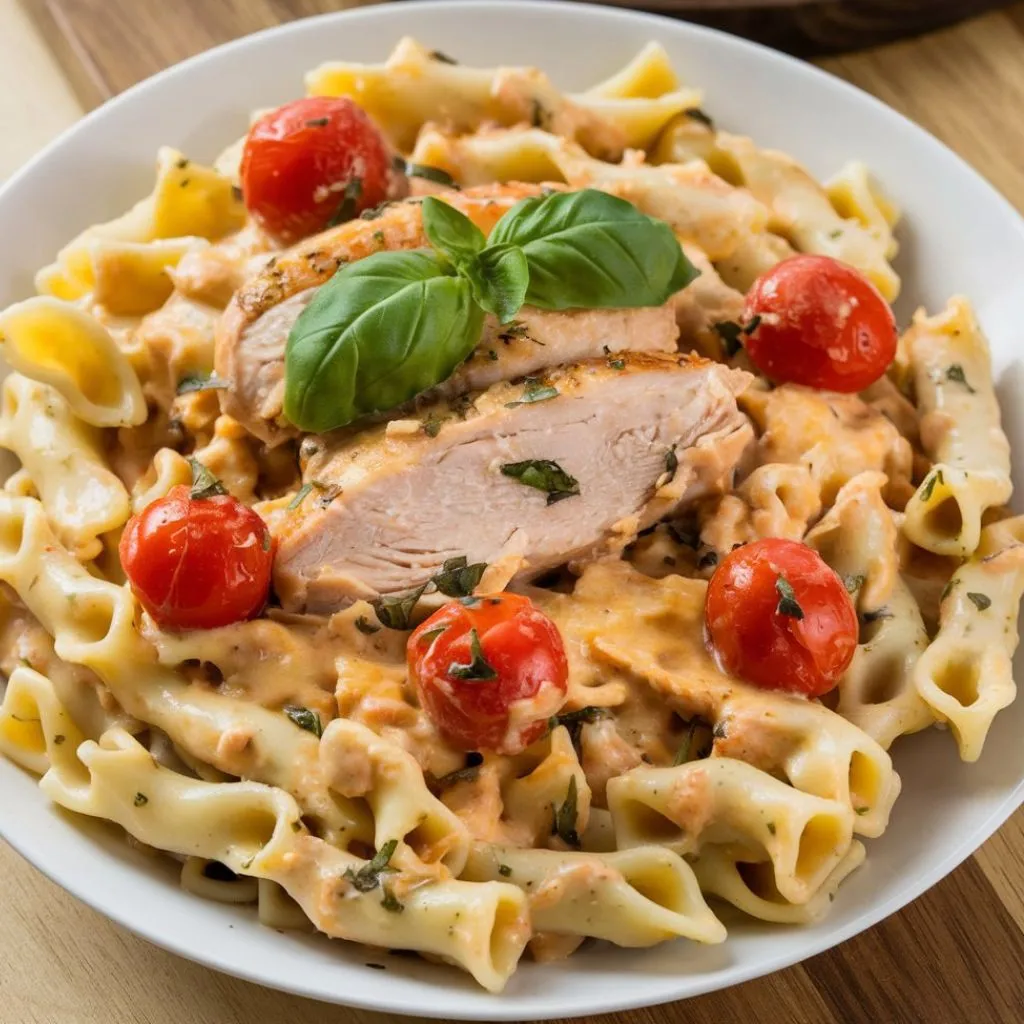
Foolproof Chicken Preparation
A perfectly prepared chicken can revolutionize an ordinary pasta dish into a spectacular garlic parmesan masterpiece. My struggles with dry, tasteless chicken led me to find that a few simple techniques make the difference between mediocre meals and restaurant-quality results. Let me share foolproof methods that will give you juicy, flavorful chicken consistently.
Simple seasoning blend that works every time
The foundation of mouthwatering garlic parmesan chicken pasta starts with a balanced seasoning blend. My testing of countless combinations helped me create this simple mixture that works:
- 1½ teaspoons sea salt
- 1 teaspoon each of dried basil and paprika
- ½ teaspoon each of garlic powder, black pepper, and Italian seasoning
- ¼ teaspoon dried thyme
This blend creates a perfect flavor base without overwhelming the creamy garlic parmesan sauce. You can store any leftover seasoning in an airtight container.
Spice lovers can add ⅛ teaspoon cayenne pepper to the mix. Another option includes ¼ teaspoon celery seed and dried parsley that adds subtle depth.
The chicken breasts should be patted completely dry with paper towels. This small step will give better browning and help seasonings stick properly to the meat.
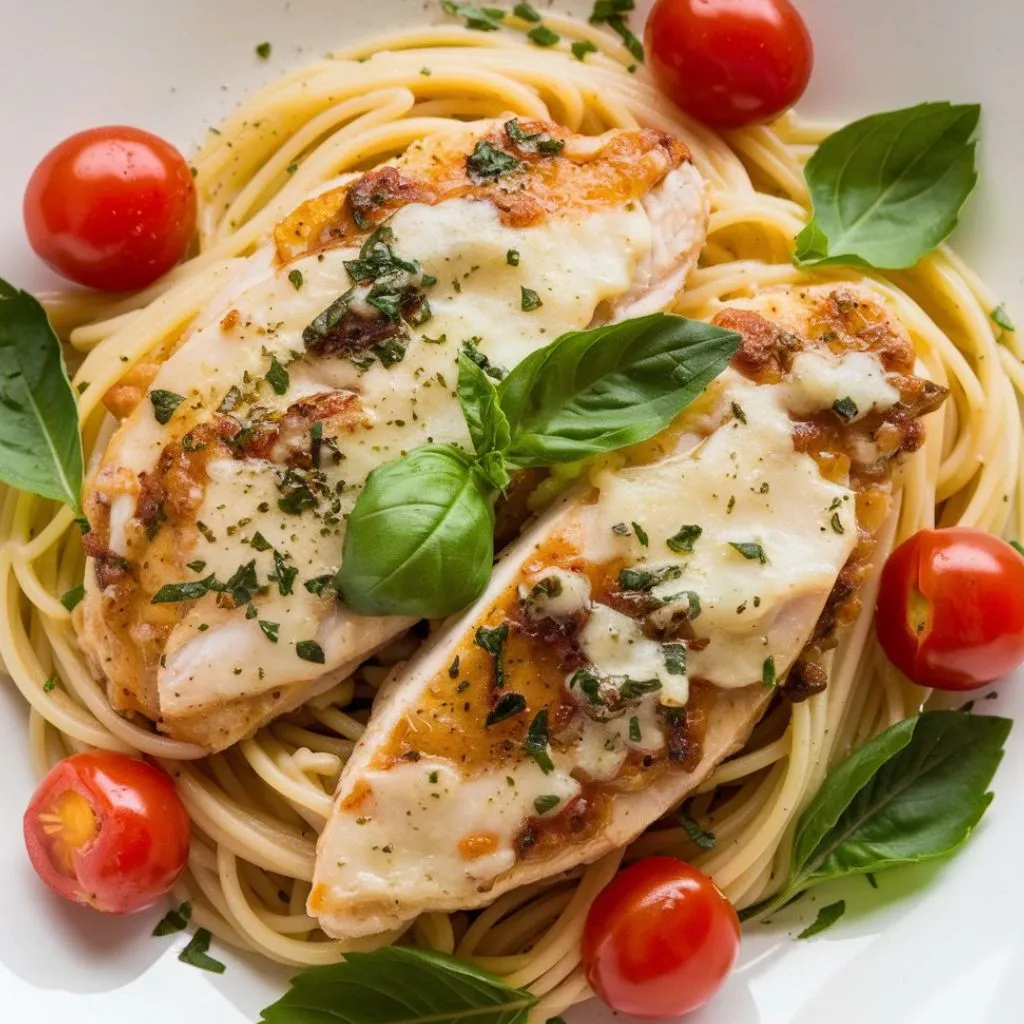
No-fail cooking method for juicy chicken
My years of experience have taught me that juicy chicken comes from a two-phase cooking approach. This method gives tender, succulent results:
- Flatten for even cooking: Use a meat tenderizer to pound chicken breasts to ½-inch thickness. The meat will cook uniformly without dry edges.
- Season generously: The seasoning mixture should be rubbed into both sides of the chicken for complete coverage.
- Initial sear: A large skillet needs medium-high heat with a tablespoon of olive oil and butter mixture. Sear each side for 1 minute until lightly golden.
- Lower and cover: The heat should be reduced to low. Cover with a tight-fitting lid and cook for exactly 10 minutes. Do not peek or lift the lid during this time.
- Rest with residual heat: The heat should be turned off completely. Let the chicken continue cooking in the residual heat for another 10 minutes with the lid on.
- Check temperature: A meat thermometer should show 165°F internal temperature after resting.
The gentle poaching environment locks in moisture while cooking the chicken. You’ll get perfectly juicy chicken that’s ready for your parmesan garlic pasta.
Time-saving preparation tips
Great garlic chicken parmesan pasta doesn’t need hours of kitchen time. These practical shortcuts save time while keeping all the flavor:
Butterfly or pound in advance: Flatten several chicken breasts during weekend prep and freeze them individually. They’ll be ready quickly when needed.
Batch-cook chicken: Extra chicken prepared this way stays good in the fridge for three days. Just slice and add it to your creamy garlic parmesan sauce while reheating.
Use kitchen shears: Kitchen shears make quick work of cutting chicken into bite-sized pieces right over the pan.
Multi-task effectively: Your pasta water should start boiling before you cook the chicken. The pasta will finish just as the sauce is ready.
Pre-mix seasonings: A large batch of seasoning blend stored in a labeled jar saves measuring time for future meals.
Dredge in flour (optional): Lightly dust seasoned chicken with flour to create a golden crust and help thicken the sauce.
These chicken preparation techniques build the foundation for exceptional garlic parmesan chicken pasta. The methods might seem detailed, but they become second nature in your cooking routine.
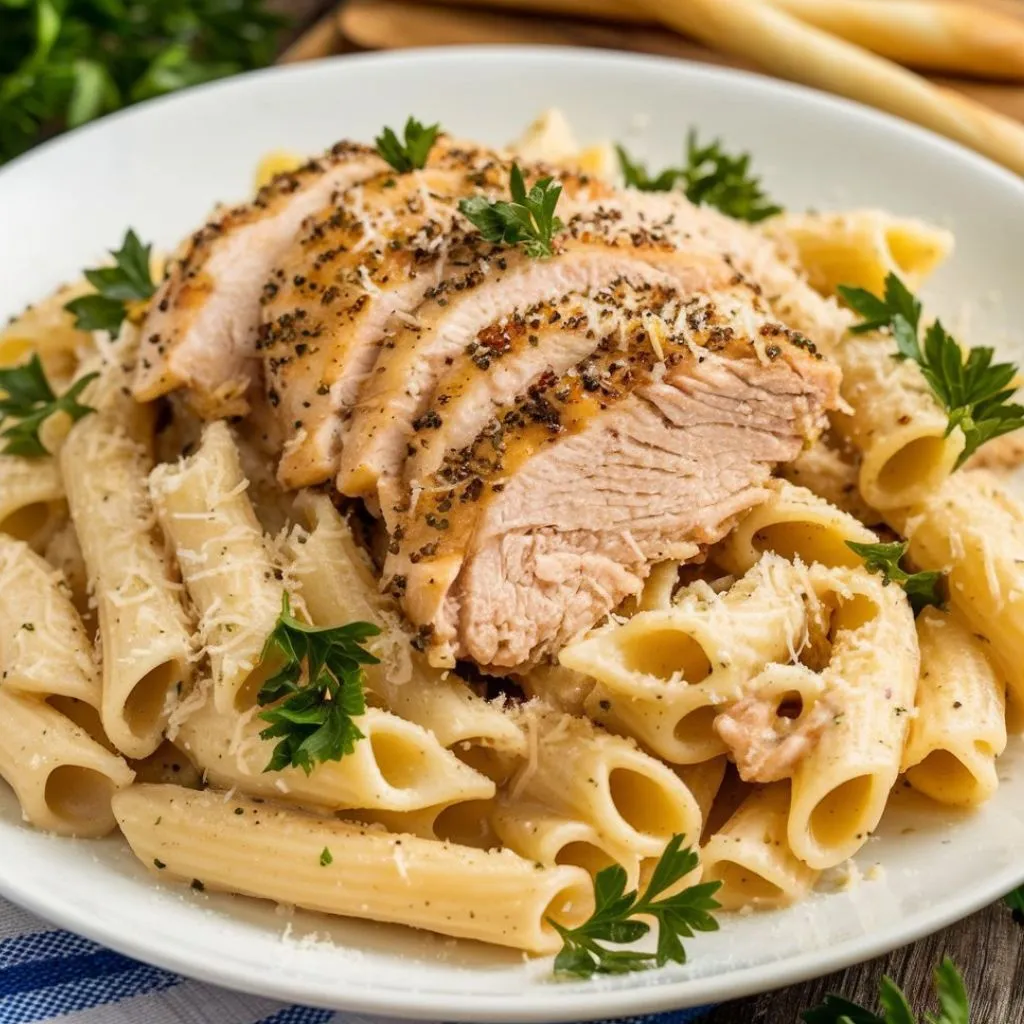
Creating a Perfect Creamy Garlic Parmesan Sauce
A velvety sauce brings everything together in exceptional garlic parmesan chicken pasta. You’ll need to become skilled at chicken preparation first. The next significant step is creating that rich, restaurant-quality garlic parmesan sauce. Let me show you how to make a sauce so good you’ll want it on everything, using just a few quality ingredients.
Step-by-step sauce-building method
The perfect creamy garlic parmesan sauce needs proper technique and attention to detail. These steps will give a consistent result:
- Start with butter and garlic: Melt 4 tablespoons of butter in a large skillet over medium-low heat. Add finely minced garlic (about 4-5 cloves) once the butter sizzles. Cook for 30-45 seconds until fragrant but not brown. Burnt garlic will make your sauce bitter and ruin the whole ordeal.
- Add your liquid base: You can either:
- Pour in ¼ cup white wine and let it simmer for 1-2 minutes.
- Whisk in 1-2 tablespoons of flour for a roux and cook for about a minute to remove the raw flour taste.
- Incorporate the cream: Whisk in 1½-2 cups of heavy cream slowly. Room-temperature cream prevents curdling in the hot pan.
- Simmer gently: Let the mixture simmer low—never boil—until it thickens and coats your spoon’s back.
- Add cheese properly: Remove from heat before adding 1 cup of freshly grated parmesan cheese. Mix in small batches until melted completely. Store-bought pre-grated cheese has anti-caking agents that make sauces grainy.
- Season to perfection: Add salt, fresh ground black pepper, and if you’d like, Italian seasoning or fresh parsley.
This 15-minute process reshapes the scene from basic ingredients into a creamy garlic parmesan chicken pasta that rivals any restaurant’s version.
Preventing common sauce mistakes
Sauce problems can happen to any cook. Here’s how to avoid the most common issues:
Temperature control makes all the difference. Hot spots are the biggest problem behind broken cream sauces. Keep a gentle simmer – boiling will make dairy proteins clump, and your sauce will separate or curdle.
Room temperature dairy works best. Cold cream in a hot pan often curdles. Take dairy ingredients out about an hour before cooking.
Fresh parmesan from a block prevents graininess. Preshredded cheese contains additives that stop smooth melting. It also helps to add cheese after taking the pan off heat, since boiling with cheese creates grainy texture.
You can fix a broken sauce. Add ¼ cup water and gently simmer while whisking – this helps ingredients come back together. Warm heavy cream while whisking also works to restore a separated sauce.
The sauce thickens naturally as the cream reduces. Pasta water works great to thin it out when needed, thanks to its starch content.
Making the sauce ahead of time
This creamy garlic parmesan sauce stays good up to 5 days ahead:
Keep it in an airtight container in your fridge. The cold sauce will thicken – that’s normal. Some separation might happen while it sits.
Reheat slowly and stir often to keep the creamy texture. Skip the microwave since it heats unevenly and might separate your sauce.
A splash of heavy cream or pasta water while reheating brings back the silky texture. This helps adjust the thickness to your liking.
For the party, make everything except adding the parmesan. When ready, heat gently to a simmer, then stir in cheese off heat. This gives you the freshest taste and best texture.
These guidelines help create the perfect creamy garlic parmesan sauce that will make your pasta dish unforgettable.
Pasta Selection and Cooking Guide
The pasta you choose for garlic parmesan chicken pasta matters as much as your sauce or chicken preparation. A good pasta shape can change an ordinary dish into something special by holding that creamy sauce in every bite.
Best pasta shapes for holding creamy sauce
Each pasta shape works differently with creamy sauces. Your garlic parmesan chicken pasta needs shapes with enough surface area to grab the sauce:
- Tubular pasta works best with chunky and thick or creamy sauces. Rotini’s corkscrew shape makes it a great choice because its ridges catch and hold the creamy garlic sauce.
- Fettuccine remains the classic choice for Alfredo sauce. It’s wide enough to catch sauce but thin enough to soak it up. The garlic parmesan sauce works great with this pasta because it’s like Alfredo.
- Other excellent options include farfalle (bow ties), fusilli, rigatoni, or penne pasta. Remember this: Thicker sauces need thicker pasta shapes.
Pasta that’s short and thick with ridges gives you the best sauce coverage. Those tiny grooves fill up with velvety sauce and pack flavor into every bite.
Foolproof cooking times for perfect texture
Getting that perfect “al dente” texture needs careful timing. The pasta should be firm but cooked through.
The water should bubble vigorously—not just simmer. This helps cook the pasta evenly and keeps it from sticking. You’ll need 4-5 quarts of water for each pound of pasta.
Dried pasta usually takes 8-12 minutes to cook. Fresh pasta cooks faster. Start tasting about two minutes before the package time suggests. Rotini needs 4 minutes of pressure cooking with a 10-minute natural release for al dente results.
Gluten-free pasta cooks faster than regular pasta. It usually takes 2 minutes or less.
Package times aren’t always right—tasting is the best way to check. The pasta should resist slightly when you bite but still feel pleasant and chewy.
How to prevent pasta from sticking
Pasta sticks because it releases starch while cooking. These techniques will keep your garlic parmesan chicken pasta’s texture perfect:
Stirring matters most in the first few minutes after adding pasta to water. Long pasta needs tongs, while shorter shapes work better with a wooden spoon. Make sure the pasta moves freely.
Oil in the cooking water doesn’t help. It makes pasta too slick, and the sauce won’t stick. Using plenty of water works better—the pasta needs room to move.
Your sauce and pasta should finish cooking at the same time. Pasta sitting in a colander will stick together. If you need to wait, mix the pasta with some sauce instead of oil.
Save some pasta water before draining. This starchy water helps mix the sauce smoothly and keeps pasta from drying out.
Mix hot pasta with your garlic parmesan sauce right away. The sauce will coat each piece better this way.
Combining Everything Into One Amazing Dish
The magic happens when you bring together all components of your garlic parmesan chicken pasta. A precise assembly will reward you with perfectly balanced flavors and texture in every bite.
The right order for adding ingredients
The sequence makes a big difference in creating creamy garlic parmesan chicken pasta. Your pasta should be cooked al dente and drained, with some pasta water saved for later. Take the same skillet you used for the chicken and heat the sauce on medium-low heat.
Add your drained pasta to the warm sauce – not the other way around. Give it a good toss to coat every strand. Next comes the sliced chicken, along with its juices from the plate. This step lets the chicken soak up the sauce’s flavors without cooking too much.
Proper mixing techniques
What sets restaurant-quality pasta apart from home cooking often comes down to mixing technique. You should employ tongs for long pasta or a wooden spoon for shorter shapes. Use a gentle folding motion instead of aggressive stirring that could break your pasta.
The sauce will stick better to pasta and chicken when you add ¼ to ⅓ cup of reserved pasta water. This starchy liquid helps create that beautiful emulsion. The sauce too thick? Just add small splashes of pasta water until it looks right.
Let everything cook together on medium-low heat for 1-2 minutes. This helps blend the flavors without drying out your dish.
Final seasoning adjustments
Your garlic parmesan chicken pasta might need a few final touches. Take a taste and think about these finishing elements:
Fresh lemon juice brightens up the rich, creamy sauce. Want more indulgence? Add an extra sprinkle of freshly grated parmesan. A dash of fresh black pepper or red pepper flakes gives that perfect hint of heat.
Note that timing matters – serve your pasta right away to enjoy the perfect creamy texture.
Variations and Adaptations for Any Situation
After learning the simple garlic parmesan chicken pasta recipe, you can explore endless customization possibilities. This versatile dish adapts to suit dietary needs and priorities without losing flavor.
Making it healthier
You can create a lighter version of traditional creamy garlic parmesan chicken pasta with these nutritious swaps:
Low-fat cream cheese or milk can replace heavy cream to cut calories while keeping the creaminess. High-protein pasta options like Banza’s lentil pasta will substantially boost your dish’s protein content. This swap turns an indulgent meal into a balanced option.
On top of that, a lighter sauce doesn’t mean less taste. Your dish stays satisfying with the core garlic and parmesan flavors, even with lighter ingredients.
Gluten-free and dairy-free options
Your dietary restrictions shouldn’t stop you from enjoying garlic parmesan chicken pasta:
To make gluten-free versions, swap regular pasta with your favorite gluten-free alternative. Note that gluten-free pasta cooks faster (about 2 minutes less than regular pasta).
To create dairy-free adaptations, full-fat coconut milk works great as a heavy cream substitute without overwhelming the parmesan flavor. Nutritional yeast can replace parmesan cheese if you avoid dairy completely.
Adding vegetables for a complete meal
Your garlic parmesan chicken pasta becomes a nutritious one-pot meal when you add vegetables:
Fresh spinach adds color and nutrients with minimal effort when wilted into the sauce at the end. Broccoli, bell peppers, mushrooms, zucchini, or asparagus make excellent additions.
The timing of vegetable additions matters – mushrooms work best when sautéed with garlic at the start, while spinach needs just the remaining heat at the end.
Spicy version with red pepper flakes
Heat lovers can raise the flavor profile of garlic parmesan chicken pasta:
Red pepper flakes work great during cooking or as a final garnish to control the heat. A few dashes of hot sauce mixed into the cream sauce spread heat throughout.
The combination of crushed red pepper flakes with lemon juice and zest creates a more complex spicy flavor that adds both heat and brightness to the rich, creamy sauce.
Conclusion
I’ve discovered that making restaurant-style garlic parmesan chicken pasta at home creates an impressive meal without breaking the bank. Once you become skilled at these techniques, you’ll achieve that perfect balance of tender chicken, silky sauce, and al dente pasta that matches any restaurant’s version.
This recipe shines because you can adapt it to your priorities. You can create a lighter version with vegetables, switch to gluten-free options, or add some heat with red pepper flakes. The dish’s signature creamy, garlic-parmesan goodness stays intact no matter how you customize it.
The right techniques guarantee consistent results – from chicken preparation to building a velvety sauce and selecting the perfect pasta shape. The dish also offers make-ahead options and smart substitutions that fit into your schedule and dietary needs.
Note that exceptional cooking starts with attention to detail and quality ingredients. Fresh garlic, authentic parmesan cheese, and the right pasta combine to create a memorable meal that brings everyone together at the table.

